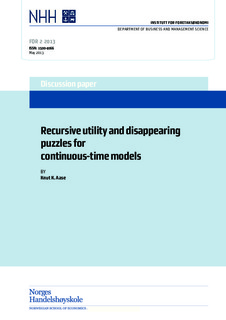| dc.contributor.author | Aase, Knut K. | |
| dc.date.accessioned | 2014-02-13T08:35:48Z | |
| dc.date.available | 2014-02-13T08:35:48Z | |
| dc.date.issued | 2013-05 | |
| dc.identifier.uri | http://hdl.handle.net/11250/164151 | |
| dc.description.abstract | Motivated by the problems of the conventional model in rational-
izing market data, we derive the equilibrium interest rate and risk
premiums using recursive utility in a continuous time model. Two
ordinally equivalent versions are considered. The state price is not
Markov in any of the versions, so instead of using dynamic programming we use the stochastic maximum principle. The resulting equilibriums are consistent with low values of the parameters of the utility
functions when calibrated to market data. One version is consistent
with preference for early resolution of uncertainty, the other for late
for the US-data. We therefore consider heterogeneity with recursive
utilities. Our resulting model rationalize data well, and can explain
both the Equity Premium Puzzle and the Risk-Free Rate Puzzle with
good margins. | no_NO |
| dc.language.iso | eng | no_NO |
| dc.publisher | Norwegian School of Economics and Business Administration | no_NO |
| dc.relation.ispartofseries | Discussion papers;2013/02 | |
| dc.subject | the equity premium puzzle | no_NO |
| dc.subject | the risk-free rate puzzle | no_NO |
| dc.subject | recursive utility | no_NO |
| dc.subject | utility gradients | no_NO |
| dc.subject | the stochastic maximum principle | no_NO |
| dc.subject | heterogeneity | no_NO |
| dc.subject | limited market participation | no_NO |
| dc.subject | optimal asset allocation | no_NO |
| dc.title | Recursive utility and disappearing puzzles for continuous-time models | no_NO |
| dc.type | Working paper | no_NO |
| dc.subject.nsi | VDP::Social science: 200::Economics: 210::Business: 213 | no_NO |
